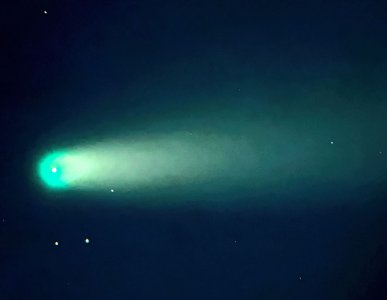Contact Information
Location
Delaware, OH 43015


 This is yet another astronomical phenomenon that often fails to live up to prediction. These predictions are made about this or that comet being the next great comet of a lifetime! Again, we must disappoint...or rather set the proper expectations. (Beginning to see a pattern here?)
This is yet another astronomical phenomenon that often fails to live up to prediction. These predictions are made about this or that comet being the next great comet of a lifetime! Again, we must disappoint...or rather set the proper expectations. (Beginning to see a pattern here?)
Comets are big hunks of ice and rock that orbit the sun in much the same way as planets with some important differences. Usually, they have very elliptical orbits that carry them far from the sun most of the time. As they near the sun at the closet part of their orbits, the sun’s energy begins to warm the comet. This causes the more volatile materials such as the gases and ices trapped in the comet to sublimate and escape from the inside through cracks in the crust. The result is a cloud of gases and dust that surround the comet we call the “coma.” Think of it as a kind of atmosphere around the nucleus. The sun’s energy influences this cloud of dust and gases. The radiation from the sun “pushes” the gases and dust away from the comet making what we call the “tail.”
Now, what does this have to do whether we will do any programs for a particular comet? The simple facts are that most often, comets are not that bright or easy to observe. A lot of these comets of course have been around a long long time, billions of years, and they have made many many trips around the sun. They have lost most of their volatiles early on. So, they just don’t give off as much gas and dust as when they first formed. They are diffuse as well, so do not reflect as much light. Even when they pass close by, the just don’ show up to well in even the biggest and best telescopes.
One should not care what they say in predictions about a particular comet. There is just no way to predict how a comet will behave as it orbits the sun. What matters is what the comet is doing at the moment. It could suddenly flare up and become bright, it can break up as comet West did in the 1970s, or it could not brighten at all because it has lost most of its volatile gases and ices. There is just no way to predict how good a comet will be.
Also, there is the issue of scale. People think bigger is better, but sorry to say that just is not so. A bigger telescope is not going to help in most cases because the coma of the comet is often huge - thousands to millions of miles across. This spreads the light out dramatically and large telescopes have a smaller field of view, so the comet can’t even fit into the view of the telescope!
If a comet does become dramatically bright and easily observable, you still don’t need us to see it. The best way to observe comets is with a small telescope or binoculars. Most can have access to these through friends or relatives (if you don’t own them yourself). When comets get bright and make a close approach, often you can even see them with the naked eye if they are releasing a lot of material. The tails tend to stretch many degrees across the sky. Here is what you need to observe comets: